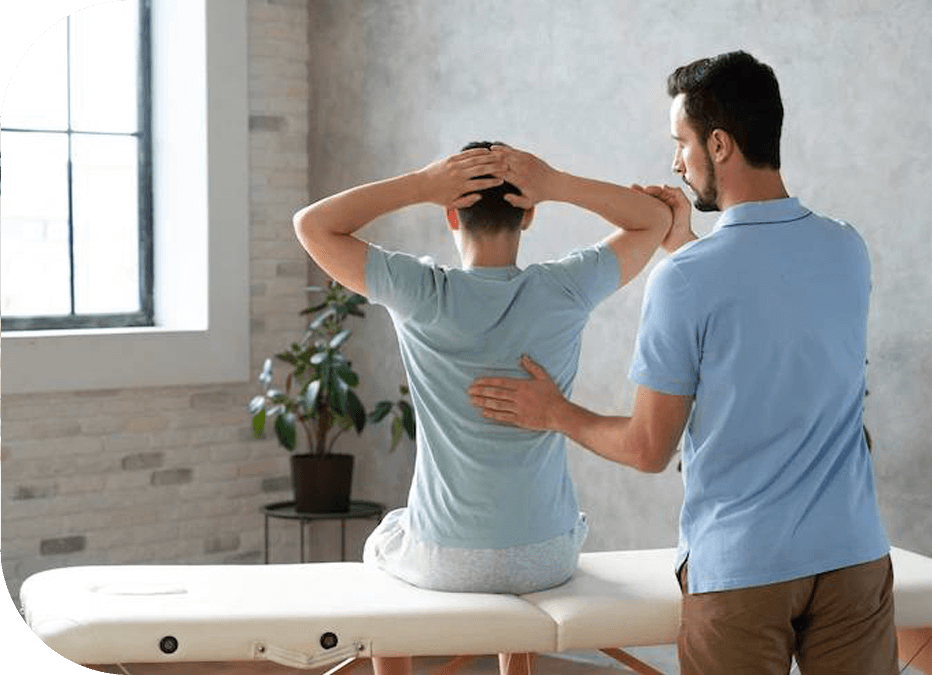
Many people suffer from neck pain and low back pain at some point during their life. You may be surprised to find that back pain impacts 80% of Americans. People who deal with low back pain will find that it impacts nearly every aspect of life. Back pain, regardless of the location or cause, may do more than cause pain at the site of the injury or medical condition.
Neck and back pain can substantially impact the ability to perform normal daily tasks, the ability to sleep, the ability to perform job requirements, and even the ability to engage in healthy exercise. Even though a majority of people suffer from back pain, many individuals do not seek medical attention. This is unfortunate, as there are multiple options a healthcare professional can recommend as part of an overall treatment plan.
But what causes neck and back pain? Young adults may suffer from neck and back pain as well as older individuals, so age is not determinative, although degenerative changes in the spine often result in back pain for older adults. Some people are born with spinal conditions that may lead to low back pain. In others, it may be an incident of acute injury, such as a car accident or a fall, which leads to back problems. Other factors that may contribute to low back problems include being overweight, failing to exercise regularly, and participating in repetitive tasks that are part of your work requirements may result in back problems. (1)
Many times, low back pain results from changes in the intervertebral discs in the spinal column. A look at the structure of the spine may provide some insight and context as to how the condition of the discs can cause resulting pain or weakness. (2)
The spine is a column of irregularly shaped bones, stacked one on top of the next. Each vertebra is somewhat rough: it is this rough surface that actually allows the attachment of the intervertebral discs. (3)
The intervertebral discs are found between each vertebra. These discs perform several very important jobs: they serve as a natural shock absorber, absorbing the motion of the vertebra. The discs also hold the vertebra together. These discs also allow the movement of nutrients into the spinal column.
Each disc is comprised of a gel-like core that is surrounded by a strong outer layer. The spinal column, then, is constructed of a column of vertebrae, with intervertebral discs found between each vertebrae. Directly behind the vertebrae and the discs is the spinal canal; the spinal canal holds the spinal nerves.
A closer look at the anatomy of the intervertebral discs provides a better understanding as to how these discs may end up as the ultimate culprit of a great many instances of back and neck pain.

The intervertebral discs have a strong outer surface and a soft inner core. One way to picture the disc is to imagine a jelly doughnut. The exterior, called the annulus fibrosis, consists of rings of flexible collagen. The interior, called the nucleus pulposus, consists of a mix of water and proteins that combine into a gel-like substance. Surprisingly, the interior of the disc is comprised of 80% water. The nucleus pulposus allows the discs to absorb the action of the vertebral column. By serving as a shock absorber, the discs allow the spine to flex and bend.
In addition to the two major parts of the intervertebral disc, the annulus fibrosis and the nucleus pulposus, located between the disc and the vertebra there is a cartilaginous endplate that actually connects each disc to the vertebrae.(4)
It is important to note that each disc is comprised of 80% water at birth. The water-based content allows the disc to be pliable. (5)
Let’s look at the main causes of spinal disc issues. These include:
Often an individual who is experiencing pain attributes it to being overworked, considering it as something akin to a severe back strain. Minor pain in the neck or back may be the only symptom an individual experiences. Many people choose to treat this type of nagging pain with over the counter pain medication and either the application of heat or ice to the area that is hurting. For these individuals, the pain may resolve in short order without any additional medical intervention required.
For other individuals, the pain resulting from a low back issue may be severe. The individual may be unable to return to their work duties because the pain is so debilitating. They may even suffer from sleep issues caused by the pain. There are more complications that can arise when someone is experiencing spinal problems: for example, nerve involvement. The most commonly know nerve condition to be involved with back pain is called sciatica.
Sciatica results when a herniated or bulging disc, in the lower back, is actually pressing onto or irritating the sciatic nerve . This creates pain that begins in the area of the compression. But the pain does not end there. This nerve pain then may travel down the nerve from the spine into the hip or buttocks and on down the leg. It is not uncommon for sciatica to cause pain all the way to the back of the knee and, in some cases, even into the foot.
The pressure on the nerve often causes pain, numbness and tingling. The individual may experience weakness when walking or rising. In some instances, the individual may experience the leg ‘giving out’ on them; in other words, suddenly the leg is not holding up the body’s weight. The pain caused by sciatica can be severe. Someone experiencing sciatica should seek out the services of a healthcare professional to ascertain the cause of the pain and to determine a course of treatment. (6)
Here is a list of some of the symptoms that may be indicative of spinal back problems:

One common diagnosis among individuals suffering from neck or back pain is a bulging disc; this is when a portion of the disc bulges out of place. The entire disc is somewhat displaced beyond what would be considered its normal boundary. This is usually caused by wear and tear over time. Many individuals have bulging discs and do not even realize it because they are not experiencing any pain. However, injury can also cause a bulging disc.(7)
To give you a better idea of what a bulging disc may look like, think of an inner tube that someone might float on down a lazy river. The wall of the inner tube should be strong. However, like a bulging disc, if a weakness occurs in a small section of the tube, you may see the tube expand (or bulge out). The wall is not completed torn, but it has significantly weakened.
A herniated disc, often referred to as a slipped disc, occurs when a small portion of the inner nucleus of the disc protrudes through the outer surface. The outer annulus fibrosis may have developed a crack through which a portion of the soft inner material may protrude. Although this can occur at any point in the spine, this type of condition usually occurs in the lower portion of the back. (8)
Herniated discs are more likely to produce pain than bulging discs. This occurs if the disc protrudes into the spinal canal where it can irritate nerve roots. In many cases painful inflammation will also develop. (9)
Herniated discs can develop over time, in the case of an aging individual; they can also result from a trauma or even during strenuous physical activity. (10)
When a herniated disc presses on a nerve, radiating symptoms often occur in the shoulder or arm (in the case of a herniated disc in the neck) or in the the buttock or leg (in the case of a herniated disc in the lower back).
Degenerative disc disease can occur when one or more of the spinal discs are weakened through wear and tear over time. Since the discs serve as a shock absorber between the spinal vertebrae, the entire spinal system may become weakened. Those areas under the most stress will often be at greatest risk for degenerative changes.
As the years pass, spinal discs eventually become dehydrated. As stated earlier, discs are comprised of 80% water at birth. As the water is lost over time, this eventually results in the discs becoming stiffer. This will prevent them from adjusting to compression the way they used to do. This is a normal part of the aging process, but that does not take away from the fact that it can cause serious back pain. (11)
Individuals suffering from degenerative disc disease may experience pain throughout the back, shooting pains in arms and/or legs, numbness or weakness.(12)
Symptoms that may indicate degenerative disc disease:
With degenerative disc disease, the pain may improve when the individual incorporates short walks into their day. This serves to alleviate the pressure on the damaged disc. Upon walking that pressure is now placed upon joints and muscles, leading to temporary pain relief. Several short walks may provide more relief than one strenuous walk. Gentle stretching before and after walking also proves to be beneficial.
Conversely, there are other movements or positions that can cause pain to increase. Sitting for long periods of time often leads to an increase in pain and stiffness when the individual rises. Bending and twisting often leads to serious pain located in the area of the damaged disc. (13)
A pinched nerve can create severe pain. In some cases a damaged disc itself is not painful; instead, the pain results when material protruding from the damaged disc pinches, or irritates, a nerve. One term used for this type of pain is radicular pain. This type of pain includes sharp shooting pain that radiates outward from the site of the nerve.
In addition to the sharp shooting pain, other symptoms of a pinched nerve include tingling sensations, numbness or weakness. This weakness can be something that persists over time, or it could come on suddenly. When this happens, the affected limb may give out without warning. (14)
Sciatica is a condition that can result from a pinched nerve in the lower spine. If material is protruding from a disc into the sciatic nerve space, it can create pain and inflammation. The irritated nerve root can result in severe pain that radiates down the back into the hip or buttocks. The pain traveling down the sciatic nerve can lead to pain behind the knee. Patients describe the pain as shooting, searing, or burning. In some instances the pain may feel like an electric jolt, and can be excruciating. (15)
When a herniated disc is compressing a nerve, inflammation usually develops at the sight of the compression. Nerve pain can be quite severe, so an individual suffering from a pinched nerve should consult a medical professional for treatment.
One approach to alleviate some of the discomfort caused by a pinched nerve is to apply ice packs to the spinal area that is affected. The ice is initially used to reduce any additional inflammation in the area.
An individual suffering from a pinched nerve should rest the area as much as possible. Getting adequate sleep and rest can allow the damaged nerve time to recuperate.
In addition, significant amounts of forward bending of the area is not recommended as this can push the contents of the disc back into the nerve. Repetitive lifting or lifting heavy objects should also be avoided until healing has occurred.
When someone is suffering from low back pain, there are many effective treatment options available. Making the decision to see a medical professional who treats low back pain may do more than alleviate painful symptoms: it may prevent more serious consequences from developing. A medical professional will develop a treatment plan appropriate to the injury or medical condition diagnosed. Generally, non-surgical intervention will be tried first, to see if that will alleviate pain and discomfort.
Non-surgical intervention is usually conservative in nature. The healthcare professional and the patient will look at options that the patient can incorporate into his or her present lifestyle and job tasks. Conservative treatment may include gentle massage, the application of ice, chiropractic care, physical therapy, the use of anti-inflammatory medications, and even a round of oral steroids to reduce inflammation.
If conservative methods are not effective after four to six weeks, your healthcare provider may decide to be more aggressive in treating the ongoing pain and discomfort. A physician may prescribe narcotic pain medication to achieve pain relief. In addition, a physician may recommend epidural steroid injections in the area of the damaged intervetebral disc.
In cases of severe low back pain where an MRI has confirmed that damage to a disc is causing the pain, there are surgical options available. Surgical options include removing part of the damaged disc or performing a spinal fusion. Other surgical options, depending upon the condition of the disc, may involve surgery to decompress the disc space. Spinal surgery should always be seen as a last option, after all other conservative options have been attempted.
The intervertebral discs of the spine perform an important function. They help to cushion the spine, allow for motion in the spine and add stability. However, the discs can also break down with overuse or injury causing a variety of painful and problematic conditions in the neck, middle back or low back areas.
In addition to localized pain and problems, the discs can also cause pressure upon nerves that can result in radiating numbness, tingling, pain and weakness.
Should you be experiencing symptoms as a result of disc problems, you should seek advice from a healthcare professional to hopefully fully resolve your condition.
References:
1. www.thegoodbody.com/back-pain-statistics/)
2.www.thegoodbody.com/back-pain-statistics/)
3. en.wikipedia.org/wiki/Vertebra
4. www.spine-health.com/conditions/degenerative-disc-disease/lumbar-degenerative-disc-disease-ddd
5.www.spine-health.com/conditions/spine-anatomy/spinal-discs
6.www.patient.info/health/spinal-disc-problems
7.www.mayoclinic.org/diseases-conditions/herniated-disk/expert-answers/bulging-disk/faq-20058428
8. www.patient.info/health/back-and-spine-pain/slipped-disc-prolapsed-disc
9. www.mayoclinic.org/diseases-conditions/herniated-disk/expert-answers/bulging-disk/faq-20058428
10. www.en.wikipedia.org/wiki/Intervertebral_disc
11. www.spine-health.com/conditions/spine-anatomy/spinal-discs
12. www.spine-health.com/conditions/degenerative-disc-disease/what-degenerative-disc-disease
13. www.spine-health.com/conditions/degenerative-disc-disease/lumbar-degenerative-disc-disease-symptoms
14. www.spine-health.com/conditions/herniated-disc/whats-a-herniated-disc-pinched-nerve-bulging-disc
15. www.spine-health.com/conditions/leg-pain/leg-pain-and-numbness-what-might-these-symptoms-mean